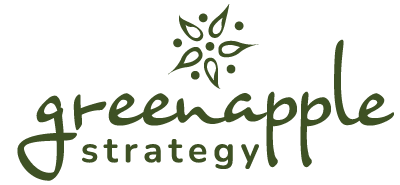Ever feel like your marketing efforts are a lot like throwing spaghetti at the wall and hoping something sticks? You’re not alone. Many small to mid-sized businesses often struggle with the idea that their marketing isn’t working. You’re putting in the effort, but the results just aren’t there.
One of the biggest culprits? Not truly understanding your audience. To connect with your customers, you need to know them like the back of your hand. That’s where customer personas come in.
Think of personas as your cheat sheet for your ideal customer. They paint a detailed picture of who your customers are, what they truly want, and what inspires them to take action. With personas, you can create marketing campaigns that feel like you’re speaking directly to each person, increasing your chances of getting them to take the next step.
At Green Apple Strategy, we’re big believers in the power of personas. We’ve seen firsthand how they can transform marketing from a guessing game into a targeted, effective strategy. In this guide, we’ll share some of the secrets we’ve learned along the way, helping you avoid common mistakes and unlock the true potential of personas.
Why Customer Personas Matter More Than You Think
Creating personas can be a game-changer. When you truly understand your audience, the payoff is huge. Don’t just take our word for it. Instead, check out these stats:
1. See Your Audience Clearly
Companies that use buyer personas have a 90% better understanding of their customers. (Source)
Knowing your customers’ pain points, preferences, and behaviors allows you to target them with content that speaks directly to their needs. Imagine being able to craft messages that resonate on a personal level, addressing their specific challenges and aspirations. That’s the power of personas.
2. Speak Their Language
82% of companies that use buyer personas report having a stronger, clearer value proposition. (Source)
With personas, you can better explain the unique benefits of your products or services, leading to a message that is compelling and clear. No more generic marketing fluff! Personas help you tailor your message to resonate with your ideal customer’s specific needs and desires.
3. Boost Engagement and Response Rates
Persona-based content can increase engagement by six times, especially when targeting cold leads. (Source)
When people see that your message is relevant, they’re more likely to click, read, and interact with your brand. It’s like you’re speaking their language, making them feel understood and valued.
4. Turn Connections into Conversions
Customer experiences built around personas can boost sales conversions by 10–15%. (Source)
A personalized approach drives trust and interest, leading to higher sales numbers and deeper customer loyalty. When customers feel like you understand them, they’re more likely to become loyal fans.
5. Cut Costs, Not Corners
Companies that use personalization can cut marketing and sales costs by 10–20%. (Source)
By knowing exactly who to target, you can streamline your marketing spend, focusing only on the channels and messages that truly work. No more wasted budget on ineffective campaigns!
6. Fuel Your Pipeline with Qualified Leads
Companies that use buyer personas see a 10% increase in leads passed on to their sales departments. (Source)
Personas help you attract more qualified leads by zeroing in on those most likely to need or want your offering. Say goodbye to tire kickers and hello to high-quality leads.
7. Exceed Your Revenue Goals
71% of companies that meet or exceed revenue goals have documented personas in place. (Source)
Personas provide the foundation for a successful marketing strategy that delivers real results. With a clear understanding of their audience, these businesses can build marketing strategies that drive measurable growth.
Common Mistakes to Avoid When Developing Personas
1. Assuming You Know Your Audience
A major barrier to developing accurate personas is assuming you already know your customers well enough. While intuition and experience play a role, it’s essential to back your personas with data. Invest the time needed to research your customers’ behaviors, desires, and challenges through surveys, interviews, and analytics.
2. Being Too Broad
If your personas are too general, they won’t be actionable. The goal is to create specific, detailed profiles that allow you to tailor your marketing. Instead of having one broad persona that applies to everyone, break your audience into distinct segments based on key differences in behaviors, needs, and decision-making processes.
3. Failing to Update Personas Over Time
It’s also important to remember that personas aren’t set in stone. Customer needs and behaviors shift. If your personas remain static, your marketing will start to feel outdated. Regularly revisit and refine your personas based on new data, customer feedback, and market trends.
4. Forgetting About Your Customers’ Internal Motivators
When creating personas, it’s easy to focus on demographic information like age, job title, and location. While these details are important, they only tell part of the story. Digging deeper into psychographics—your customers’ internal motivators, values, and beliefs—gives you a more complete picture. Understanding these motivators helps you create messaging that not only appeals to customer needs but also resonates with their values, driving a deeper connection.
Keys for Turning Personas Into Marketing Strategies
1. The Inside Scoop: Gather Team Insights for Developing Personas
Your internal teams are one of your most valuable resources in defining personas. It’s essential that your marketing department taps into the knowledge of your sales and customer service teams. They’re on the front lines, interacting with customers every day. They can provide invaluable insights into customer challenges, objections, and motivations.
By collaborating with these teams, you’ll get a well-rounded view of your customers so that your personas are rooted in real-world experiences.
2. Straight From the Source: Leverage Focus Group Feedback
Sometimes, the best way to understand your audience is by speaking directly with them. Focus groups or customer interviews allow you to validate your personas with direct feedback.
At Green Apple, we often conduct focus groups when a client is launching a new product or entering a new market. The insights gained are invaluable and often reveal customer priorities or concerns that we may not have considered.
3. Speak Their Language: Crafting Content That Resonates With Each Persona
If you want your marketing efforts to resonate, you need to develop content themes that speak directly to different personas (e.g., blog topics, case studies, or whitepapers). The good news is that AI tools make it easier than ever to tailor website copy, ads, and email campaigns based on persona-specific pain points and motivations. Use persona-driven storytelling to make marketing more relatable and engaging.
4. Syncing Up: Aligning Sales and Marketing with Persona-Driven Strategies
When sales and marketing are aligned, every interaction feels more personal and effective. That’s why it’s helpful to make sure your sales team really understands your personas so they can tailor their conversations and outreach. You can take it a step further by equipping them with helpful sales-enablement tools like FAQs, guides, and automated email campaigns designed for each persona’s journey.
5. Persona-Powered Ads: Reach the Right People With the Right Message
You wouldn’t send the same message to a teenager and a retiree, right? The same goes for your marketing personas. You need to segment your ad campaigns so that you’re hitting the right people with the right message. Don’t forget about those helpful ‘lookalike’ audiences on Facebook and LinkedIn! These AI tools can help you find even more potential customers.
Ready to Make Your Marketing More Human?
Building detailed customer personas is a crucial step toward creating marketing that truly connects. By understanding your audience on a deeper level, you can craft campaigns that resonate, engage, and drive results.
Want to learn more about how Green Apple Strategy can help you develop impactful customer personas and a winning marketing strategy? Let’s chat! We’re passionate about helping businesses like yours achieve their goals through strategic, human-centric marketing.








